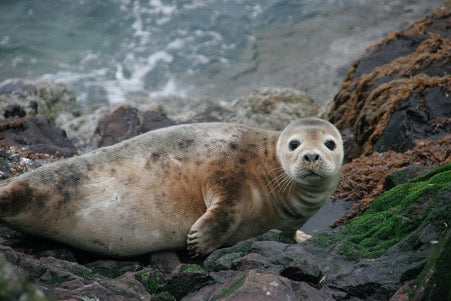A Tranquil Distillery Famous for its "Giraffes" - The Glenmorangie Distillery
Distillery Spotlight: Glenmorangie Distillery
Region: Highland, Scotland
Note: Our Distillery Spotlight articles discuss how each distillery's unique process results in the distinctive flavour profiles of their whisky. To find out more about each step of the whisky-making process, check out our Basics Series article on how to distil the elixir of life.

The distillery by the Tarlogie Springs at twilight (Image source: Sainsbury’s)
The location and etymology of the distillery are some of the very many captivating factors behind the Glenmorangie brand. Once upon the time before growing English influence, Scottish people spoke the Scottish Gaelic tongue. These people referred to the vast and serene coast of Dornoch Firth by which the distillery sits as “Gleann Mòr na Sìth”, meaning “the Valley of tranquillity”.

View of the Dornoch Firth by Glenmorangie (a “firth” refers to an inlet of saltwater or coastal waters in Scottish) (Image Source: Google Images (Deano G))
You will not find many conventionally touristy attractions if you search for the Glenmorangie distillery on Google Maps. But book a stay at the nearby hotel called the Glenmorangie House (owned by the proprietors of the distillery) to experience hiking, clay pigeon shooting, dining and drinking in the Scottish Highlands. You might seriously not want to return home.

The grounds of the Glenmorangie House in winter (Image Source: Glenmorangie House)
Brief history
In 1843, William Matheson took over an old beer brewery near the Tarlogie Springs in the village of Tain, and converted the brewery into a whisky distillery. The distillery was purchased by the Macdonald family in 1918, which later seemed like terrible timing. Almost immediately, it suffered many a downturn through the 1920’s Prohibition and Great Depression and then a barley shortage which started in World War II and persisted till the 1950s. Yet the faith of the Macdonald family paid off as the distillery began to flourish from the 1970s onwards.
After 90 years of ownership by the Macdonald family, the distillery was acquired by Moët Hennessy Louis Vuitton, which rebranded a number of its product lines for an appeal to the luxury goods market abroad. The Glenmorangie also appears to be the Scots’ go-to single malt, being the best-selling single malt in Scotland almost every year since 1983.
Water sourced from the Tarlogie Springs

Glenmorangie’s label with their “Signet” logo
Take a look at the bottom part of the Glenmorangie label. You will find a square device with a whirling maze of linked patterns that replicates the whorls that you see when water is added to whisky, and which is echoed by the water streaming over the sand and limestone in Glenmorangie’s Tarlogie Springs.
Since 1843, this water sourced from Tarlogie Springs has been a prized asset in Glenmorangie’s process. As rain patters on stone and water forces its way through layers of limestone and sandstone, natural magnesium and calcium are picked up, giving it an unusually high amount of minerals compared to the water used by other Highland distilleries.
This hard water that is rich in magnesium and calcium imparts a very subtle crisp and sweet taste is intended to come through the light character of Glenmorangie’s whiskies and compliment the light fruity flavours.
The distillery jealously guards this water so much that, in 1989, it decided to purchase the entire 650 acres of forest that surrounds the Tarlogie Springs to keep this water pure.
“Giraffe” copper stills
We have discussed how the Macallan distillery’s short and tiny copper stills help create the rich and heavy-bodied spirit that Macallan is famous for.
Glenmorangie is just the opposite in this respect. The reason for the signature light-bodied and clean-tasting expressions are the famous big giraffe-like stills used by Glenmorangie. These are the tallest distillation stills in Scotland, measuring 5.14 metres tall.

Glenmorangie’s giraffe stills (Image Source: Philippines Tatler)
During the distillation process, alcohol and other compounds from fermentation try to climb up the neck of these stills. These tall stills are shaped as such so that heavier compounds are unable to climb up the neck, and end up hitting the inner walls of the still, condensing back into the pot. This way, only alcohol and lighter flavour compounds are able to climb up the neck and leave the stills as light, delicate and fresh tasting distilled spirit.
High quality American oak
Glenmorangie’s distillery manager, Dr Bill Lumsden, also takes the wood used for maturation very seriously.
Generally, only American white oak is used for maturation which gives a softer, sweeter taste with notes of vanilla and caramel (and is less spicy and bold than European). The wood is not purchased, but rather grown in Glenmorangie’s own forest in the Ozark Mountains of Missouri, United States. Then, they are leased to bourbon distillers such as Jack Daniel’s for bourbon maturation for at least four years, before being returned to Glenmorangie as ex-bourbon casks. Lumsden only uses each cask for maturation twice.
While many of Glenmorangie’s product range mature entirely in ex-bourbon casks, some ranges are transferred to a spend a short period in wine, port or sherry casks– a step known as finishing. It is noteworthy that Lumsden himself is a pioneer of the finishing process – the technique of giving a second period of maturation in an “active” cask. These “active” casks have been heat-treated and burnt on the inside to have many pores that increase the surface area of contact for better interaction with the spirit.
Lumsden’s finishing process adds a new twist and complexity to the flavour. Of course, balance is key and too much maturation can ruin the flavours of the whisky. Considering the very light tasting spirit that Glenmorangie is known for, this balance has to be skilfully struck by Lumsden. Lumsden has himself explained on the differences between Macallan and Glenmorangie’s styles, and how the Glenmorangie distiller cannot go nuts with a bold-flavoured cask:
“The best way to compare would be to study a glass of Glenmorangie new make spirit alongside a glass of Macallan new make spirit. By its very nature, Macallan stands up well to full maturation in sherry casks, whereas ours does not.”
Glenmorangie’s iconic flavour profile

(Image Source: Glenmorangie distillery)
Glenmorangie’s use of water sourced from Tarlogie Springs, giraffe-tall stills, and high quality ex-bourbon American oak casks are responsible for the whisky’s signature fresh, light-bodied and smooth texture with creamy notes of sweet vanilla, malt, cinnamon and pineapple.
Typical Glenmorangie expressions tend to have the following taste profile:
Colour:
- Yellow gold
Nose:
- Fragrant and floral
- Orange peel, vanilla, banana split and coconut ice-cream
Palate:
- Crisp and light-bodied
- Smooth texture
- Orange peel and pineapples
- Light oak character, vanilla, cinnamon
- Creamy crème brulee
Finish:
- Medium length, minty and cool
An unexpected lesson in conservation

A furry seal basking on the coast of Dornoch Firth (Image Source: Wild Scotland)
Today the Dornoch Firth is alive with a diversity of wildlife which includes seaweed, mussels, birds and seals. However, an important creature missing is the humble oyster, which disappeared after overfishing in the 19th century.
The waters of Dornoch Firth have supported the distillery for 180 years as it developed into a renowned international brand. While the water of Dornoch Firth (through Tarlogie Springs) is used for making whisky, unfortunately, the undesirable stuff not committed to casks is ultimately dumped into the Dornoch Firth at the end of production.
While distillery sells over half a million cases of whisky annually, Glenmorangie’s continued ability to source water from the Tarlogie Springs- and its future as a distillery- will depend on its ability to preserve the health of the Dornoch Firth. The once-present oysters would have been able to clean the waters because they are filter-feeders that have the ability to clean up human-caused pollution in water bodies.
This is why the distillery has engaged in conservation efforts, including a partnership with biologists at the UK Marine Conservation Society to reintroduce oysters into the ecosystem. The undesired by-products of distillation, which once went out to sea, will now go to local barley farmers as soil fertiliser.
Speaking of oysters, one cannot think of a more perfect pairing than some oysters and a scotch. The crisp and sweet flavours of an Glenmorangie 10 will brilliantly compliment the maritime, briny flavours of oysters from the Dornoch Firth.
Our Take
Just as is the case for many very commercially successful distilleries, there is an element of unease with monetary success. The distillery’s acquisition by Moët Hennessy Louis Vuitton is shortly followed by new ranges with bemusing French-sounding expressions such as “Nectar d'Or” and “LaSanta”.
In any case, one could argue it is not so much that Glenmorangie sought to appeal to the market, as it is the case that much of the market (from Scotland to China) already loves the sweet, crisp and light-tasting distillery character of Glenmorangie.

A chocolate mousse cake with malted barley ice cream infused with the delicious Glenmorangie Signet, made by the award-winning chefs at the Glenmorangie House.
Glenmorangie delivers many very affordable expressions of good quality that are approachable for the new comers and reliable to long-time drinkers. Even the higher-end expressions are relatively affordable. For drinkers already familiar with the entry level expressions, the older expressions are very strongly recommended as they provide satisfying complexity and depth with the same amount of smoothness- these are well worth their price.
Our favourites are:
Entry Level: Glenmorangie 10 – the Original; Glenmorangie A Midwinter Night's Dram; Glenmorangie Nectar d'Or
Moderate: Glenmorangie Signet; Glenmorangie 19 Years Old Finest Reserve; Glenmorangie A Tale of Cake
Top Shelf: Glenmorangie 25 Year Old Quarter Century; Glenmorangie Pride 1978

@charsiucharlie





